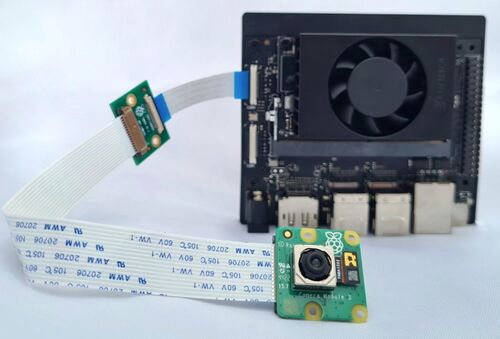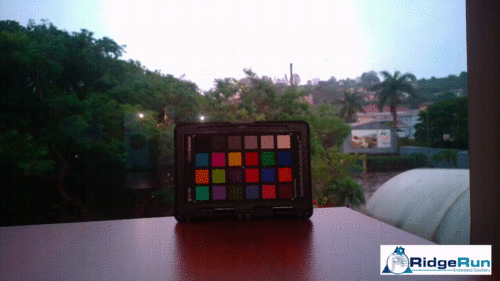Difference between revisions of "NVIDIA Jetson Orin Nano/Camera Sensors Support/IMX708"
(Created page with "<noinclude> {{NVIDIA Jetson Orin Nano/Head|next=|metakeywords=|metadescription=}} </noinclude> This wiki provides information about enabling the Raspberry Pi Camera V2.1 (IMX...") |
|||
| (29 intermediate revisions by 2 users not shown) | |||
| Line 1: | Line 1: | ||
| + | |||
<noinclude> | <noinclude> | ||
{{NVIDIA Jetson Orin Nano/Head|next=|metakeywords=|metadescription=}} | {{NVIDIA Jetson Orin Nano/Head|next=|metakeywords=|metadescription=}} | ||
</noinclude> | </noinclude> | ||
| − | This wiki provides information about | + | |
| + | |||
| + | This wiki provides information about the IMX708 camera sensor driver developed by RidgeRun. The information provided was tested on: | ||
<pre> | <pre> | ||
| − | * JetPack: 5.1.1 | + | * Jetson Orin Nano developer kit from NVIDIA |
| − | * | + | * JetPack version: 5.1.1 |
| − | * | + | * Linux for Tegra version: 35.3.1 |
| + | * 1x IMX708 Rapsberry Pi Camera Module V3 | ||
</pre> | </pre> | ||
| − | |||
| − | |||
{| class="wikitable" style="margin: auto;" | {| class="wikitable" style="margin: auto;" | ||
| − | |[[File: | + | |[[File:IMX708-ORIN-NANO.jpg|thumb| center | 500px | Figure 1: Raspberry Pi 3 Camera Module 3 connected to a NVIDIA® Jetson Orin Nano™]] |
| − | |||
|} | |} | ||
| − | |||
| − | |||
| − | |||
| − | |||
| − | + | =Raspberry Pi Camera Module 3 & driver features= | |
| + | The Raspberry Pi Camera V3 camera module (IMX708) is compatible with the Jetson Orin Nano developer kit from NVIDIA. The IMX708 is a cost-effective camera module capable of capturing a resolution higher than 4K. Table 1 shows a few interesting characteristics of the camera module. The driver developed by RidgeRun has the specifications shown in Table 2. If you need to extend the driver to meet your project needs, feel free to [https://www.ridgerun.com/contact contact us]. | ||
| − | |||
| − | |||
| − | |||
| − | |||
| − | |||
| − | |||
| − | |||
| − | + | {| class="wikitable" style="margin: auto;" | |
| + | |+ Table 1: Raspberry Pi Module 3 specs | ||
| + | |- | ||
| + | ! Parameter !! Description | ||
| + | |- | ||
| + | | Image sensor || IMX708 | ||
| + | |- | ||
| + | | Optical Size || 1/2.43(7.4mm sensor diagonal) | ||
| + | |- | ||
| + | | Number of effective pixels || Height = 4608, Width = 2592 <br> | ||
| + | |- | ||
| + | | Pixel Size || 1.4μm × 1.4μm | ||
| + | |- | ||
| + | | Interface || MIPI CSI-2 Interface | ||
| + | |- | ||
| + | | Shutter Type || Rolling Shutter | ||
| + | |- | ||
| + | | Color Filter || Color | ||
| + | |- | ||
| + | | Minimun Focus Distance || 5 cm | ||
| + | |- | ||
| + | | Binning Support || Yes | ||
| + | |- | ||
| + | | HDR Support || Yes | ||
| + | |- | ||
| + | | Auto-Focus (PDAF) || Yes | ||
| + | |} | ||
| − | |||
| − | |||
| − | |||
| − | + | <br> | |
| − | + | {| class="wikitable" style="margin: auto;" | |
| − | < | + | |+ Table 2: Driver specs |
| − | + | |- | |
| − | + | ! Parameter !! Description | |
| − | + | |- | |
| − | + | | Pixel Depth || RAW10 | |
| − | + | |- | |
| − | + | | Resolution || 4608 x 2592 | |
| − | + | |- | |
| − | + | | Framerate || 14.35 | |
| − | + | |} | |
| − | |||
| − | |||
| − | |||
| − | |||
| − | |||
| − | |||
| − | |||
| − | |||
| − | + | You can use V4L2 or GStreamer to capture using the RidgeRun driver. Figure 2 below is a screenshot of the video obtained using the following GStreamer pipeline on the Orin Nano: | |
| − | |||
| − | |||
<pre> | <pre> | ||
| − | + | nvidia@ubuntu:~$ GST_DEBUG="GST_TRACER:7" GST_TRACERS="framerate" gst-launch-1.0 nvarguscamerasrc sensor_id=1 -e ! 'video/x-raw(memory:NVMM),width=4608,height=2592,framerate=14/1, format=NV12' ! nvvidconv ! x264enc tune=zerolatency insert-vui=true pass=quant quantizer=32 speed-preset=ultrafast bitrate=5000 ! mpegtsmux ! filesink location=output_office_cam1.mp4 | |
| − | |||
| − | |||
| − | |||
</pre> | </pre> | ||
| − | + | {| class="wikitable" style="margin: auto;" | |
| − | + | |[[File:IMX708-ORIN-NANO-VIDEO.gif|thumb| center | 500px | Figure 2: Raspberry Pi 3 Camera Module 3 recording (4608x2592@14.35fps)]] | |
| − | + | |} | |
| − | |||
| − | |||
| − | |||
| − | + | = Installation Instructions = | |
| − | |||
| − | |||
| − | |||
| − | |||
| − | |||
| − | |||
| − | |||
| − | |||
| − | |||
| − | |||
| − | |||
| + | Please refer to [https://developer.ridgerun.com/wiki/index.php/Raspberry_Pi_Camera_Module_3_IMX708_Linux_driver_for_Jetson this guide] to have a complete guide to install the driver in the Jetson Orin Nano. We widely recommend reading the whole guide in order to get a better understanding on what is the installation guide flow. Once you have read the wiki, consult the [https://developer.ridgerun.com/wiki/index.php/Raspberry_Pi_Camera_Module_3_IMX708_Linux_driver_for_Jetson Index] and visit the exact section you need. | ||
<noinclude> | <noinclude> | ||
{{NVIDIA Jetson Orin Nano/Foot||}} | {{NVIDIA Jetson Orin Nano/Foot||}} | ||
</noinclude> | </noinclude> | ||
| + | |||
| + | {{ContactUs}} | ||
| + | |||
| + | [[Category:Jetson]][[Category:Jetson V4L2 Drivers]][[Category:Sony]] | ||
Latest revision as of 10:22, 8 August 2023
NVIDIA Jetson Orin Nano RidgeRun documentation is currently under development. |

|
This wiki provides information about the IMX708 camera sensor driver developed by RidgeRun. The information provided was tested on:
* Jetson Orin Nano developer kit from NVIDIA * JetPack version: 5.1.1 * Linux for Tegra version: 35.3.1 * 1x IMX708 Rapsberry Pi Camera Module V3
Raspberry Pi Camera Module 3 & driver features
The Raspberry Pi Camera V3 camera module (IMX708) is compatible with the Jetson Orin Nano developer kit from NVIDIA. The IMX708 is a cost-effective camera module capable of capturing a resolution higher than 4K. Table 1 shows a few interesting characteristics of the camera module. The driver developed by RidgeRun has the specifications shown in Table 2. If you need to extend the driver to meet your project needs, feel free to contact us.
| Parameter | Description |
|---|---|
| Image sensor | IMX708 |
| Optical Size | 1/2.43(7.4mm sensor diagonal) |
| Number of effective pixels | Height = 4608, Width = 2592 |
| Pixel Size | 1.4μm × 1.4μm |
| Interface | MIPI CSI-2 Interface |
| Shutter Type | Rolling Shutter |
| Color Filter | Color |
| Minimun Focus Distance | 5 cm |
| Binning Support | Yes |
| HDR Support | Yes |
| Auto-Focus (PDAF) | Yes |
| Parameter | Description |
|---|---|
| Pixel Depth | RAW10 |
| Resolution | 4608 x 2592 |
| Framerate | 14.35 |
You can use V4L2 or GStreamer to capture using the RidgeRun driver. Figure 2 below is a screenshot of the video obtained using the following GStreamer pipeline on the Orin Nano:
nvidia@ubuntu:~$ GST_DEBUG="GST_TRACER:7" GST_TRACERS="framerate" gst-launch-1.0 nvarguscamerasrc sensor_id=1 -e ! 'video/x-raw(memory:NVMM),width=4608,height=2592,framerate=14/1, format=NV12' ! nvvidconv ! x264enc tune=zerolatency insert-vui=true pass=quant quantizer=32 speed-preset=ultrafast bitrate=5000 ! mpegtsmux ! filesink location=output_office_cam1.mp4
Installation Instructions
Please refer to this guide to have a complete guide to install the driver in the Jetson Orin Nano. We widely recommend reading the whole guide in order to get a better understanding on what is the installation guide flow. Once you have read the wiki, consult the Index and visit the exact section you need.
|
RidgeRun Resources | |||||||||||||||||||||||||||||||||||||||||||||||||||||||
| |||||||||||||||||||||||||||||||||||||||||||||||||||||||
|
|||||||||||||||||||||||||||||||||||||||||||||||||||||||
| Visit our Main Website for the RidgeRun Products and Online Store. RidgeRun Engineering informations are available in RidgeRun Professional Services, RidgeRun Subscription Model and Client Engagement Process wiki pages. Please email to support@ridgerun.com for technical questions and contactus@ridgerun.com for other queries. Contact details for sponsoring the RidgeRun GStreamer projects are available in Sponsor Projects page. |  
|



